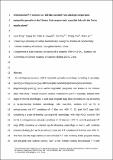Files in this item
Anticlockwise P-T evolution at ∼280 Ma recorded from ultrahigh-temperature metapelitic granulite in the Chinese Altai orogenic belt, a possible link with the Tarim mantle plume?
Item metadata
| dc.contributor.author | Tong, Laixi | |
| dc.contributor.author | Xu, Yi-Gang | |
| dc.contributor.author | Cawood, Peter A. | |
| dc.contributor.author | Zhou, Xin | |
| dc.contributor.author | Chen, Yibing | |
| dc.contributor.author | Liu, Zhao | |
| dc.date.accessioned | 2016-08-10T23:32:56Z | |
| dc.date.available | 2016-08-10T23:32:56Z | |
| dc.date.issued | 2014-11 | |
| dc.identifier | 157934146 | |
| dc.identifier | 2ba35aa6-0977-46b0-bf03-1209285cceba | |
| dc.identifier | 000343351000001 | |
| dc.identifier | 84906496836 | |
| dc.identifier | 000343351000001 | |
| dc.identifier.citation | Tong , L , Xu , Y-G , Cawood , P A , Zhou , X , Chen , Y & Liu , Z 2014 , ' Anticlockwise P-T evolution at ∼280 Ma recorded from ultrahigh-temperature metapelitic granulite in the Chinese Altai orogenic belt, a possible link with the Tarim mantle plume? ' , Journal of Asian Earth Sciences , vol. 94 , pp. 1-11 . https://doi.org/10.1016/j.jseaes.2014.07.043 | en |
| dc.identifier.issn | 1367-9120 | |
| dc.identifier.uri | https://hdl.handle.net/10023/9285 | |
| dc.description.abstract | An ultrahigh-temperature (UHT) metapelitic granulite assemblage consisting of garnet(g)–spinel(sp)–orthopyroxene(opx)-sillimanite(sil)–cordierite(cd)–ilmenite(ilm)–biotite(bi)–plagioclase(pl)–quartz(q) occurs within migmatitic paragneiss near Kalasu in the Chinese Altai, NW China. Textural relations, mineral compositions and P-T estimates, indicate three stages of mineral assemblages: (1) pre-peak prograde stage (M1) consisting of a sp–sil-bearing or sp–opx-bearing inclusion assemblage, with low-Al2O3 contents (4–5 wt.%) in orthopyroxene and P-T conditions of ∼7 kbar and ∼890 °C, (2) peak UHT stage (M2) comprising a g–opx–cd-bearing coarse-grained assemblage, with high-Al2O3 contents (8–9 wt.%) in orthopyroxene and peak conditions of ∼8 kbar and ∼970 °C, and (3) post-peak HT stage (M3) containing an oriented opx–bi–sil-bearing assemblage in matrix, with moderate amounts of Al2O3 (6–7 wt.%) in orthopyroxene and P-T conditions of 8–9 kbar and ∼870 °C. The three discrete stages define an anticlockwise P-T path involving initial prograde heating and post-peak near isobaric cooling. Such a near isobaric cooling anticlockwise P-T path suggests that UHT metamorphism likely occurred in an overall extensional tectonic setting with associated underplating of mantle-derived mafic magma. A SHRIMP zircon U–Pb age of 278 ± 2 Ma obtained from the metapelitic granulite indicates UHT metamorphism in the Altai orogen occurred during the Permian, coeval with spacially associated mantle-derived mafic intrusions (∼280 Ma) and the Tarim mantle plume (∼275 Ma). Thus, the Permian UHT metamorphism of the Chinese Altai is likely associated with underplating and heating of mantle-derived mafic magma as a result of the Tarim mantle plume. | |
| dc.format.extent | 11 | |
| dc.format.extent | 2041723 | |
| dc.language.iso | eng | |
| dc.relation.ispartof | Journal of Asian Earth Sciences | en |
| dc.subject | Ultrahigh-temperature metamorphism | en |
| dc.subject | The Chinese Altai | en |
| dc.subject | P-T path | en |
| dc.subject | U-Pb age | en |
| dc.subject | Mantle plume | en |
| dc.subject | Zircon U-PB | en |
| dc.subject | NW China | en |
| dc.subject | Tectonic evolution | en |
| dc.subject | Central-Asia | en |
| dc.subject | Continental growth | en |
| dc.subject | Northwest China | en |
| dc.subject | Accretionary orogenesis | en |
| dc.subject | Geological implications | en |
| dc.subject | Crustal metamorphism | en |
| dc.subject | Isotopic composition | en |
| dc.subject | GB Physical geography | en |
| dc.subject.lcc | GB | en |
| dc.title | Anticlockwise P-T evolution at ∼280 Ma recorded from ultrahigh-temperature metapelitic granulite in the Chinese Altai orogenic belt, a possible link with the Tarim mantle plume? | en |
| dc.type | Journal article | en |
| dc.contributor.institution | University of St Andrews. Earth and Environmental Sciences | en |
| dc.contributor.institution | University of St Andrews. School of Geography and Geosciences | en |
| dc.contributor.institution | University of St Andrews. Scottish Oceans Institute | en |
| dc.contributor.institution | University of St Andrews. St Andrews Isotope Geochemistry | en |
| dc.identifier.doi | 10.1016/j.jseaes.2014.07.043 | |
| dc.description.status | Peer reviewed | en |
| dc.date.embargoedUntil | 2016-11-01 |
This item appears in the following Collection(s)
Items in the St Andrews Research Repository are protected by copyright, with all rights reserved, unless otherwise indicated.

